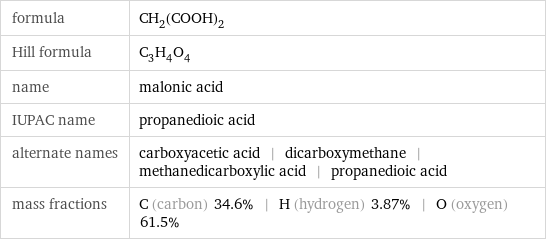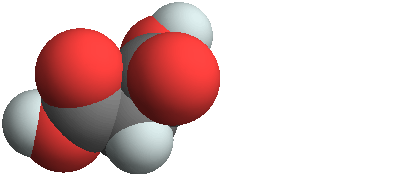Input interpretation

malonic acid
Chemical names and formulas

formula | CH_2(COOH)_2 Hill formula | C_3H_4O_4 name | malonic acid IUPAC name | propanedioic acid alternate names | carboxyacetic acid | dicarboxymethane | methanedicarboxylic acid | propanedioic acid mass fractions | C (carbon) 34.6% | H (hydrogen) 3.87% | O (oxygen) 61.5%
Lewis structure

Draw the Lewis structure of malonic acid. Start by drawing the overall structure of the molecule, ignoring potential double and triple bonds: Count the total valence electrons of the carbon (n_C, val = 4), hydrogen (n_H, val = 1), and oxygen (n_O, val = 6) atoms: 3 n_C, val + 4 n_H, val + 4 n_O, val = 40 Calculate the number of electrons needed to completely fill the valence shells for carbon (n_C, full = 8), hydrogen (n_H, full = 2), and oxygen (n_O, full = 8): 3 n_C, full + 4 n_H, full + 4 n_O, full = 64 Subtracting these two numbers shows that 64 - 40 = 24 bonding electrons are needed. Each bond has two electrons, so in addition to the 10 bonds already present in the diagram add 2 bonds. To minimize formal charge oxygen wants 2 bonds and carbon wants 4 bonds. Identify the atoms that want additional bonds and the number of electrons remaining on each atom: Fill in the 2 bonds by pairing electrons between adjacent highlighted atoms: Answer: | |
3D structure

3D structure
Basic properties

molar mass | 104.06 g/mol phase | solid (at STP) melting point | 136 °C boiling point | 387 °C density | 1.669 g/cm^3 solubility in water | very soluble
Units

Hydrophobicity and permeability properties

predicted LogP hydrophobicity | -0.59 predicted LogS | 0.28
Basic drug properties

approval status | experimental | small molecule
Solid properties (at STP)

density | 1.669 g/cm^3 vapor pressure | 5×10^-7 mmHg (at 25 °C)
Units

Thermodynamic properties

molar heat of vaporization | 69.8 kJ/mol specific heat of vaporization | 0.671 kJ/g (at STP)